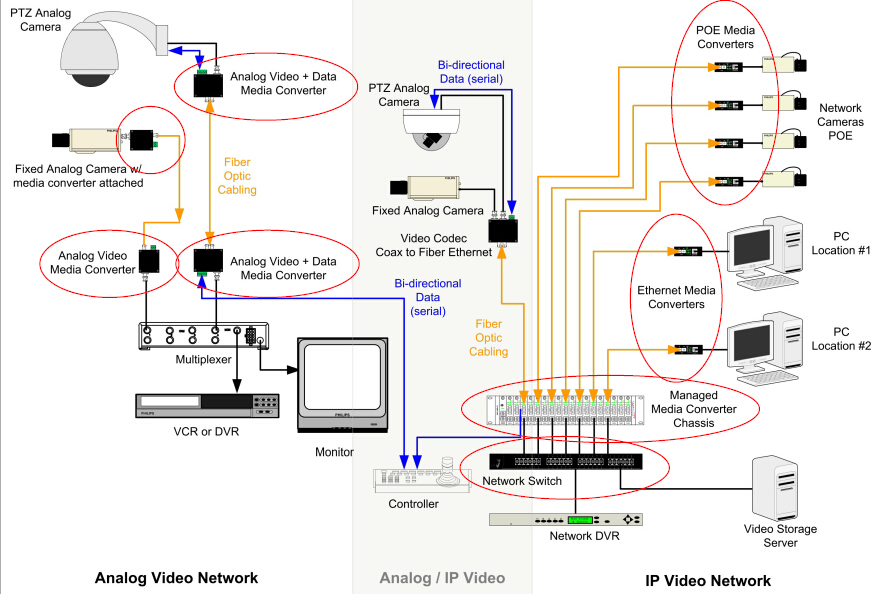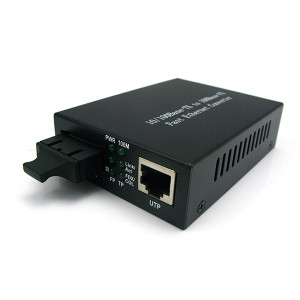Overview of Video Technology
As the video security technology rapidly advances, many new video technologies are applied in our daily life for entertainment or some special managements. The commonly seen video technologies include Analog video and IP video. For example, the security video cameras are usually offered in one of these two formats. In addition, Analog video or IP video camera functionality falls into two broad categories – Fixed and PTZ (Pan Tilt Zoom). The former is typically for entry doors, hallways, gates etc. while the latter is typically used in retail, casinos, etc. where the ability to change camera view is required and the cameras are actively controlled.
Features of Analog Video
• Optical transmitters modify signal output based on video content
• Modifications include amplitude (AM) or frequency (FM)
• Most commonly used for security and surveillance applications
• Tried and true technology and still the lowest cost option today
• Over 80% market share today for new installations
Typical Analog Video System
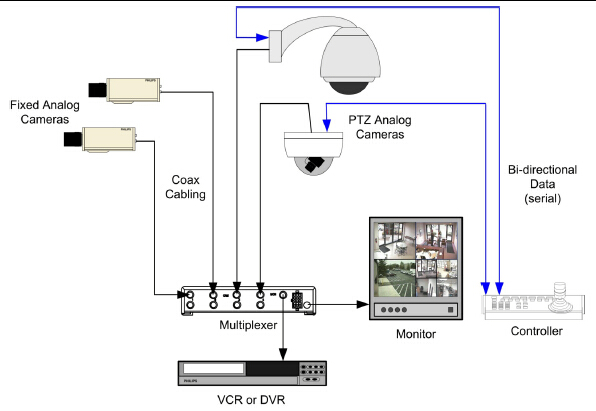
228 meter (750ft) distance limitationon coaxial cabling runs
Features of IP Video
• Video camera automatically encodes the video output into IP packets
• Video output can be transmitted directly over a traditional Ethernet LAN
• Power over Ethernet technology benefits
• Gaining popularity in security and surveillance applications
• Estimated to gain 50% + market share by 2010
Typical IP Video System
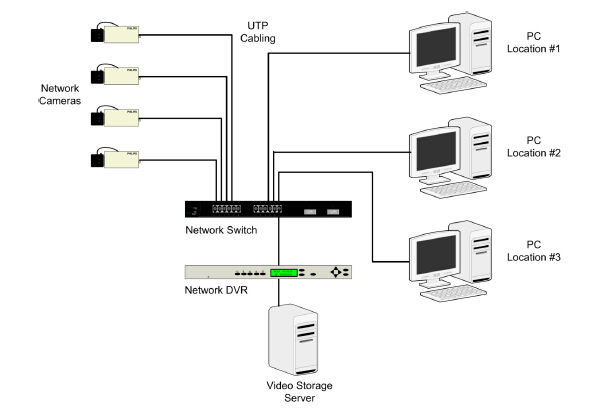
100 meter (328ft) distance limitation on all UTP cabling runs
Common Issues of Video Security & Surveillance System
In a video security & surveillance system, as ever increasing reach of surveillance, it usually leads to quality, bandwidth and transmission distance issues. In addition, the traditional copper (coax or UTP) cabling can not satisfy the requirements and new camera locations may require new cabling which cost much. Moreover, in today’s video security and surveillance systems, there are many IP camera installations co-existing with analog camera networks which leads to cabling mismatch if upgrading cameras and extended reach of network beyond original design for new cameras.
Copper-based Cabling vs Fiber Cabling
Limitation of copper-based cabling
With the higher and higher demands of video security & surveillance systems, copper-based cabling seems not too much suitable due to its limitations itself. About the limitations of copper-based cabling, we may explain form the following there aspects:
>> Limited transmission distances
• Coaxial cable < 228 meters (750 ft.)
• UTP cable < 100 meters (328 ft)
• Requires more equipment or signal conditioning / amplification to increase distance
>>Susceptible to electrical interference
• Noise, high voltages and ground faults
>>Quality and security risks
• Quality effected by distance and interference
• Copper-based cabling easy to tap into
Benefits of fiber cabling
Nowadays, fiber cable are widely used and gradually replaced the copper cable in the video security & surveillance systems. With the benefits of fiber cabling, many limitations are solved. The benefits of fiber cabling as the following:
>>Allows for extended transmission distances
• Multimode cable < 2km (1.24 miles)
• Single mode cable > 2km
>>Smaller size, less weight and better tensile strength
• Easier installation when pulling through conduit or overhead cable trays
>>Usually existing as network backbone in vertical risers and between buildings
• Reduce cost by utilizing existing fiber infrastructure
• Improve quality, bandwidth and distance of video system
>>High degree of security –difficult to tap into or interfere with
>>Immunity to electrical interference such as:
• Electromagnetic interference (EMI)
• Radio frequency interference (RFI)
• High voltage interference caused by: Fluorescent lights, Card access door strikes and Outdoor lighting systems
>>Induced voltages caused by ground potential differences between locations
• Occurs in over 50% of all video security systems
Fiber Deployment
As we know, if we deploy new devices with fiber ports, it’s not only expensive but also with limited availability. In order to save cost and shorten the deploying time, we usually use copper-to-Fiber media converters. Nowadays media converters are the proven technology which allows the integration of fiber optic cabling in copper environments and have successfully used in LANs and WANs of retail, government, education, enterprise, service providers and industrial. (Learn more about fiber media converter)
Typical Video Network Diagram
Fiber Integration In Analog Video Networks
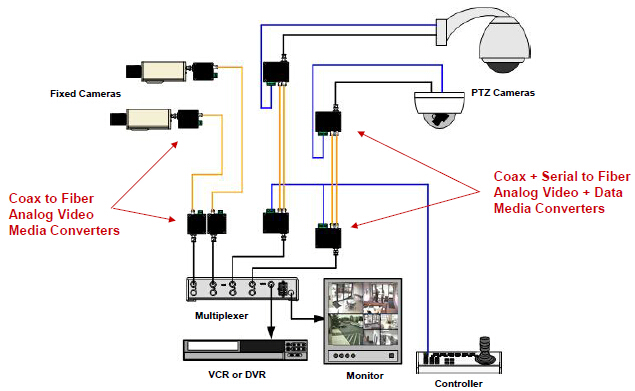
Fiber Integration in IP Video Networks
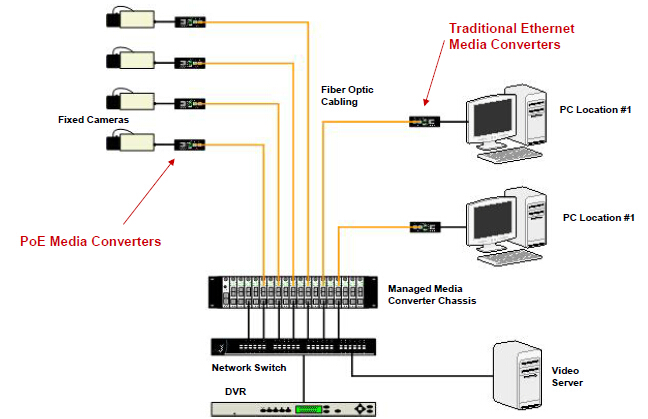
Analog/IP Video Over Fiber Network
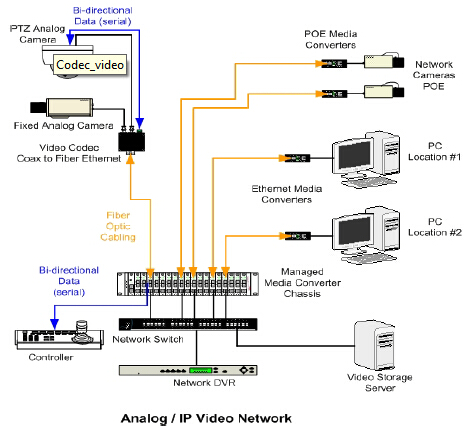
Hybrid Video over Fiber Network
Summary
In this article, we have leant the role of fiber in video security & surveillance network through realizing the anolog and IP video technologies as well as the comparison of the copper-based cabling and the fiber cabling. In addition, we have a short introduction of fiber deployment which let us know the important use of fiber media converters in video security & surveillance network.
Warm Tips: If you want to get more details about media converters and the related products such as PoE switches, you could visit fs.com or leave message to us over sales@fs.com.

